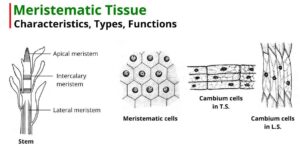
Collenchyma Cells: Structure, Types, Functions
Collenchyma is a simple permanent tissue composed of living cells with thickened walls. It is a part of the ground tissue and provides support and mechanical strength to the newly…

Collenchyma is a simple permanent tissue composed of living cells with thickened walls. It is a part of the ground tissue and provides support and mechanical strength to the newly…

Parenchyma is a simple permanent tissue that makes up large portions of various plant organs. It consists of thin-walled living parenchymatous cells. The word parenchyma comes from the Greek words…

Meristematic tissue is a type of plant tissue in which the cells divide continuously and help in plant growth. The meristematic tissue is also known as a meristem. It is…

Fungi lack the chlorophyll pigment essential for independent existence. Hence, they must get their food from other living organisms or from dead or decaying organic matter. Economical fungi have great…

Bacteria exert both deleterious and benefical effects on human life. Beneficial species liberate fertilizer elements for growing crops, destroy sewage and other wastes, and produce valuable chemicals. Some species are…

The Pteridospermales or Cycadofilicales are characteristic gymnospermous plants that bore fern-like foliage, which in turn bore seeds that were unprotected. Hence, they are known as seed ferns. Pteridospermales is a…

The Bennettitales (Cycadeoidales) are a fossil group found from the Triassic to the lower Cretaceous, but were predominant in the Jurassic period of the Mesozoic era in South America, North…

Sexuality in fungi is diverse and fascinating. In fungi, gradual degeneration of sexuality can be observed. Degeneration of sexuality means functional and structural degeneration of sex organs, leading to the…

Fungi are eukaryotic, spore-bearing microorganisms. They are heterotrophic (i.e., can’t produce their own food through photosynthesis) and digest food externally by releasing hydrolytic enzymes into their surroundings. Fungi have unicellular…

The classification of the fungi is a very challenging task since it presents various problems that originate from the differences of opinion of different workers. The situation becomes even more…